1.Resource utilization of rural waste
Case: A village in northern China has established a "straw-sawdust" mixed pelletizing project. It purchases corn stalks from nearby farmers and sawdust from wood processing plants. After crushing and drying, it uses a pellet machine to produce fuel pellets, which are supplied to villagers for heating in winter. The project processes 12,000 tons of waste annually, reduces coal consumption by 8,400 tons, lowers villagers' heating costs by 30%, and generates an annual income of 1.2 million yuan for the village collective.

2. Fuel transformation for industrial boilers
A certain paper mill has phased out coal-fired boilers and switched to wood pellet fuel, equipped with two 5-ton-per-hour pellet machines, making full use of the wood waste in the factory area for self-sufficiency. After the transformation, sulfur dioxide emissions will be reduced by 150 tons annually, nitrogen oxide emissions will be cut by 40%, and fuel costs will be saved by approximately 2 million yuan per year (the price of pellet fuel is lower than that of coal).
3. New Forms of International Energy Trade
Due to the demand for energy transition, Europe imports a large amount of wood pellets from North America and Southeast Asia for power generation. For instance, the southern United States is rich in forest resources. Through pellet machines, the processing residues of pine and fir are made into pellets and exported to countries such as the United Kingdom and Germany. By 2024, the export volume is expected to reach 18 million tons, forming a "green energy trade chain".
From forest waste to the warmth in the furnace, and from industrial waste to clean energy in the power grid, the transformation process of bio-pellets confirms the possibility of "innovation making resources sustainable"





















